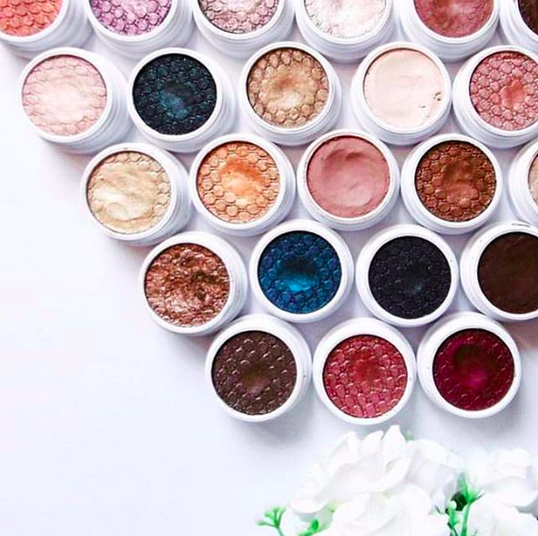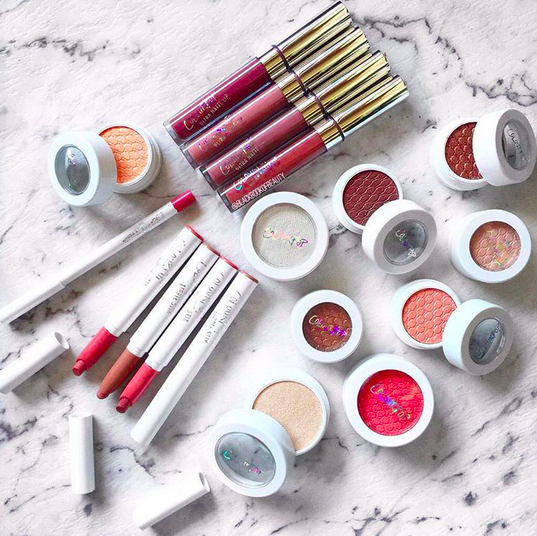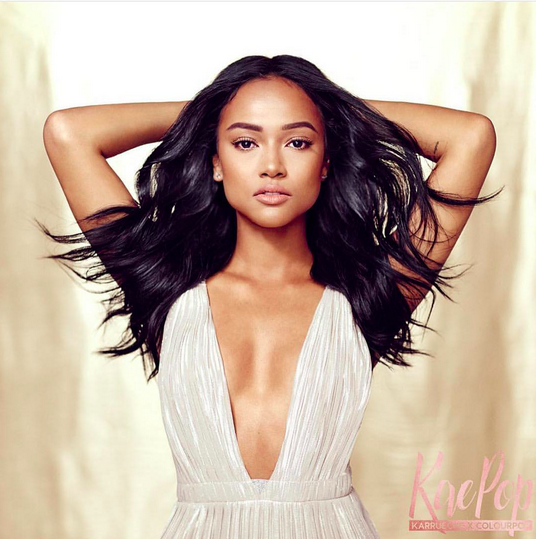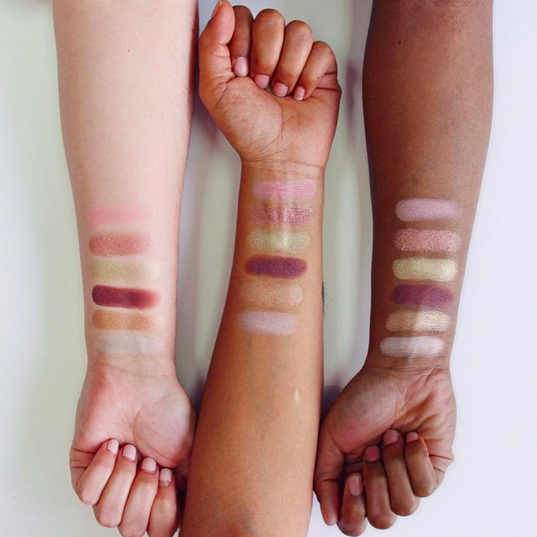ColourPop, Beauty’s Most Secretive Indie Brand, Opens Up

A sampling of ColourPop’s Super Shock Shadows. (Photo: @colourpopcosmetics)
One of the most popular makeup brands on Instagram is also one of the most mysterious. With 1.7 million followers on social media, collaborations with Jaime King and Karrueche Tran on deck, and a nod from Women’s Wear Daily as 2015’s Mass Beauty Launch of the Year, ColourPop cosmetics is arguably one of the most exciting color cosmetics brands on the market. Not bad for a brand that was founded in May 2014.
But for all the buzz surrounding them, ColourPop’s owners have stayed out of the spotlight. There was even speculation on Reddit that the “Illuminati” was behind the brand. ColourPop’s founders are actually a brother and sister with 15 years of beauty business experience apiece. John and Laura Nelson started the ColourPop brand under the umbrella of their company, Seed Beauty — which, Laura says, strives to “incubate new brands.” The first of these brands was ColourPop, but according to the Seed Beauty website, they have three additional brands they’re developing and two more they’re acquiring.
As we said, for all the hype around ColourPop, we hadn’t heard much from its owners. Fashionista recently ran a story charting the brand’s rise on social media, noting the difficulty they had getting to speak with the owners. But it seems that at this point in the game, John and Laura are beginning to open up more about their brand, and for good reason — people are curious. Luckily for us, we got a chance to chat with Laura one-on-one about how this small Los Angeles-based company turned into such an huge phenomenon. “There are some questions about who we are and where we came from,” Laura told us in a phone interview last week. “We’re always happy to have the opportunity to tell our story.”
One of the things that is most amazing about the ColourPop story is how the core spirit of its brand has manifested itself in its growth. “The idea was really the opportunity to bring forth what we think are amazing formulations and a ton of shades at a price point that really allows for experimentation,” Laura explained. “At the end of the day, we really wanted people to have premium, quality products at a price that wasn’t overly committal, that would allow you to try the latest greatest shades, and take yourself a little bit outside your comfort zone at a price that wasn’t going to break the bank. If purple eyeshadow was all the rage, for $5, you can give it a try. It’s not the end of the world! We really wanted to break down some of the barriers between price point and accessibility and fun and really just the opportunity to experiment and have a good time.” Makeup for the people, as I like to call it.

More of ColourPop’s products. (Photo: @colourpopcosmetics)
This same democratic spirit is a trending thread through many aspects of the company. The price points are accessible. The product testing and development are highly collaborative – from what Laura told me, it seems that it’s a balance of the ColourPop team’s expertise and what the brand’s fans want to see from them. Plus, ColourPop itself grew in popularity from one of the most democratic platforms of them all: social media. It was the user-generated content from men and women trying the products — who could speak about the quality of the products in a way that regular Joes and Janes could trust — that really helped set things off for the brand, rather than shopping the products around to the media. Laura says the buzz started on Instagram, and then flooded to YouTube, thanks to vloggers reviewing and using their products. “You don’t necessarily have to wait for a traditional print beauty magazine to come out to tell you what’s the latest and greatest,” Laura said of ColourPop’s social media appeal. “It’s very immediate, it’s very personal, and it really does allow people to share the good, bad, and the ugly in very real time. That was very key to our growth and our success and it continues to be today.” It’s ben so successful there is even an Instagram fan club dedicated to it called ColourPop Cult. The account — which Laura follows and says she is “humbled” by — has 66,000 followers.
But what is most interesting about ColourPop, I think, is its business model. ColourPop is only sold online, possibly to the distress of superfans who would love to take a trip to their local drugstore or beauty supply shop to purchase some of the products. They will have to be content with the online arrangement, because according to Laura, there are no plans for ColourPop to make the leap to traditional retail. “E-commerce and controlling our own domain and destiny is part of the magic of Colourpop, and what makes us unique within the marketplace,” she said. “That’s something we would never give up, regardless. E-commerce is what our main focus is.”
Indeed, it is this e-commerce-focused model that is instrumental to ColourPop’s success. Aside from the fact that the products are wildly affordable (we’re talking $5 for a lipstick or eyeshadow, $6 for a gel liner pot, and $8 for a highlighter), they’re suited to many skin tones. While it is always in a color cosmetics brand’s best interests to cater to people of all shades, ColourPop seems to be committed to showing diversity in its advertising and on social media — which, as someone who almost obsessively follows beauty brands, is not all that common.
Representation is a hot topic in the beauty community. Just a few weeks ago, a few beauty junkies, vloggers, and artists of color posted an image to Instagram reading, “Dark Beauty Matters.” The point was to address the fact that many brands fail to feature women of darker complexions in their advertising and on thei r social media accounts, or cater to them with their products. As beauty guru Jackie Aina said in a post to her Instagram followers, “I don’t follow a lot of beauty pages on IG anymore because aesthetically everything looks the same to me, just being honest. Subliminal messages are often much louder than the ones in your face. Some people would rather post a photo of clown contouring or their dog before highlighting an artist of dark skin on their page.” Fortunately, this is an issue that ColourPop doesn’t have. And, as Laura explained to us, their business model helps make this possible.

A promo image from ColourPop’s upcoming collaboration with Karrueche Tran. (Photo: @colourpopcosmetics)
“We aren’t constrained by some of the traditional parameters of a retailer, having a certain amount of SKUs, having certain timing, and things like that. There’s a lot of freedom that comes with e-commerce, and as a part of that, we can develop shade ranges that — hopefully — speak to as many different skin tones and complexions and tastes as we possibly can,” she told us. “That’s absolutely key. In every product development, with every shade we’re working on, we make sure that we can really address that as much as possible and that’s always a goal going in. We do a lot of testing on all different skin tones and different types of consumers.” And it shows. For many of their products, ColourPop includes swatches on dark, medium, and light skin – which, anyone who has ever tried to shop for makeup online can tell you, is rare. “That’s always are goal and something we’re trying to achieve, and I think that part of that, again, is because our business model allows us to open up those shade ranges and create shades that are going to work for everybody.” Indeed, it seems that without the focus on e-commerce, it would be difficult for ColourPop to exist and have the appeal it does.

ColourPop swatches on dark, medium and light skin. (Photo: @colourpopcosmetics
Though it’s not necessarily a household name, ColourPop has become such a huge hit that we don’t think it will be too long before it gains the brand recognition of other more established brands like Urban Decay, Kat Von D, or Too Faced Cosmetics. And while their seemingly overnight success may come as a surprise to some, Laura said that she knew ColourPop was something special early on — particularly by the fall 2014, when their lippie stix began to take off. “While today is very dynamic and exciting and busy, the early days, those were certainly some of the most fulfilling. You would get a certain number of orders a day, and you’re so excited that anyone is on your website,” she said. “Not losing touch with that excitement that every single order matters; every single customer is so important today, as they were on day one or day two.”
ColourPop is obviously still growing. Their product catalogue includes their Super Shock shadows and pigments, Crème Gel Colour and Gel Liners, Super Shock bronzers, blushes and highlighters, Lippie Pencils, Lippie Stix and Ultra Matte Lip products. There are no options for mascara, foundation, concealer, or face powder, nor are there any eyeshadow palettes. But as demand grows, we have little doubt that ColourPop will rise to the occasion and create new, affordable products, as they have been doing. And we’re sure that their future launches will be just as wallet-friendly and inclusive as they have always been.
Follow us on Facebook, Instagram, and Pinterest for nonstop inspiration delivered fresh to your feed, every day.
